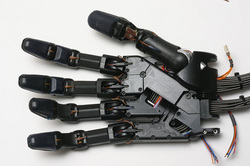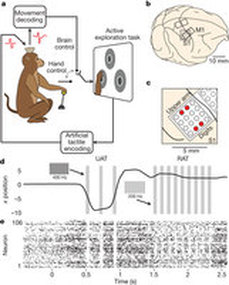Scientific breakthrough brings us one step closer to mind control over artificial limbs
March 02, 2012
By Destie Provenzano Imagine the sense of loss one feels after losing a limb, never being able to feel the softness of a loved ones face or feel the coarse fur on an adoring pet? Though scientists have made several breakthroughs in designing mentally movable prosthetic limbs, none had succeeded in restoring a person's ability to feel. Recently, scientists in Durham have succeeded in doing the impossible in primates, bringing us one step closer to solutions for humans. Mind Control In October of 2011, Duke researchers successfully bridged the gap between biology and mechanics by connecting a mechanical arm to a living primate and allowing it to control it with its mind. Their device not only allowed the primate to mentally control the limb as its own, but for the first time allowed it to FEEL sensory inputs through this prosthetic device. This pivotal study by Dr. Nicolelis M.D. Ph.D P.I. and his team, published in Nature (Nicolelis, 2011), detailed the process of implanting mechanical devices into a monkey’s brain, allowing the monkey to recognize textures felt with this device. The study built upon our previous knowledge of the “Brain-computer-interface," or the intersection between living brain tissue and man-made technology. Studies on the “BCI” have been attempted as early as the 1970s (Fetz, 1969). By matching up severed nerve endings with electric wires, researchers substituted real limbs for mechanical ones. What began as electrodes in rats grew to computer screens hooked to monkeys and digitalized interpreters that permit human paraplegics to communicate. (Newburg, 2003) Monkeys have been able to control prosthetic limbs, move joysticks, and play computer games as early as 2003 with their minds alone (Nicolelis, 2003). However the “brain-machine” interface that allowed them to do this had a pitfall: it lacked the ability to send information back from the mechanical device to the monkey’s brain (allowing the subject to "feel"). Miguel Nicolelis’s group decided to target this lack of a “closed-feedback loop.” The Experiment
Nicolelis’ study attempted to bridge this loop and create a “brain-machine-brain” interface by implanting electrodes in both the somatosensory cortex and the motor cortex of the monkey brain. A monkey with said electrodes was tasked with controlling a virtual prosthetic arm on a computer screen. Different “disks” that contained information coding for textures corresponding to rough and fine sensations were placed in front of the monkey on the screen. If the monkey’s virtual arm touched a certain type of disk, a certain amount of electronic “pulses” was sent back to the monkey’s brain, informing it of the different type of texture. If the monkey chose the correct texture with its virtual arm, it was rewarded. Identical looking disks were placed on the screen to control for visual input bias.
After testing the arm, the researchers used a different monkey and placed electrodes instead where the brain would typically register a “foot.” Astoundingly, the researchers found that in the case of both monkeys, the monkeys could distinguish different textures for reward within as little as four training sessions. This experiment suggests that the brain’s cortical plasticity allows it to not only control and send output via foreign objects, but to also receive feedback.The results were promising; however the study still leaves room for improvement. Monkeys in a previous experiment with similar implanted electrodes showed more accurate results when the monkeys were able to move a virtual “avatar” with a manual joystick. Nonetheless, this study produced by far more positive results, the full study by Nicolelis presents evidence that devices can not only be incorporated, but fully controlled by thought alone. (is that what you meant to say? I didn't understand the original sentence.) This experiment suggests that the brain’s cortical plasticity allows it to not only control and send output via foreign objects, but to also receive feedback.
 Get involved in robotics research!
Potential Uses
So where does the research go from here? Scientists are now looking for clinical applications in humans for this new technology. BCI’s have been attempted in humans since as early as 1978. The devices have grown from simple electrodes implanted into the visual cortex, to complicated movement enabling commercial interfaces that place nearly 100 electrodes into the precentral gyrus and allow the user to control objects. Nicolelis already has plans for his own clinical model in humans, including returning movement to paraplegics and allowing surgeons to control fine tuned surgery robots. It isn’t hard to imagine where the field could go from there, expanding to devices we could clip into to move objects across rooms, control computers, and make and move our lives using only our brains. How to Get Involved A budding scientista interested in this line of work can get involved by pursuing biomedical engineering programs at any stage of her career. Mechanical engineering, computer science, biology, and biomedical engineering are all excellent segues into biomedical engineering Ph.D programs, although it is also possible to breach out from other lines of work as well. Research laboratories at MIT, Duke, UPenn, Johns Hopkins, and many more are all making excellent headway in the field and present opportunities to get involved. Individuals interested in this line of work can follow the BCI route, or expand their background to gait analysis, neuro-computational work, and many other biological-mechanical implementations. --- References http://www.nature.com/nature/journal/v479/n7372/full/nature10489.html Image 1 diagram: http://www.nature.com/nature/journal/v479/n7372/carousel/nature10489-f1.2.jpg About the AuthorDestie Provenzano is a graduate of the Massachusetts Institute of Technology. She spent four years researching Myotonic Dystrophy at MIT, a summer researching bird Genetics at the Smithsonian, and most recently Congenital Muscular Dystrophy at the NIH.
Liked this article? Read more News!
Comments?
|
The Scientista Foundation, Inc. All Rights Reserved © 2011-2021 | Based in NY | [email protected]
The Network for Pre-Professional Women in Science and Engineering
The Scientista Foundation is a registered 501(c)(3) -- Donate!
The Network for Pre-Professional Women in Science and Engineering
The Scientista Foundation is a registered 501(c)(3) -- Donate!
